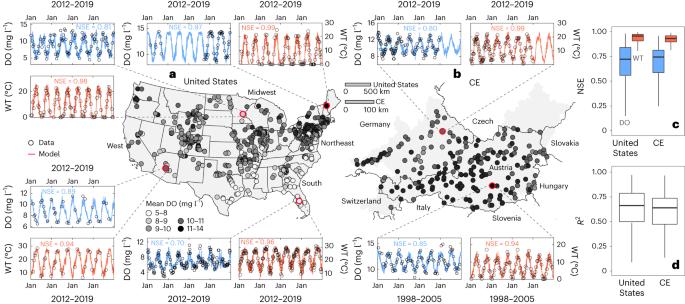变暖的河流普遍脱氧
IF 27.1
1区 地球科学
Q1 ENVIRONMENTAL SCIENCES
引用次数: 0
摘要
脱氧现象在海洋和湖泊中很常见,但在较浅的流动河流中则较少见。在这里,我们利用时间天气和水质数据以及静态流域属性(如水文气候、地形、土地利用、土壤)训练了一个深度学习模型,重建了美国 580 条河流和中欧 216 条河流的日水温和溶解氧。结果显示,87% 的河流持续变暖,70% 的河流出现脱氧现象。城市河流的变暖速度最快,而农业河流的变暖速度最慢,但脱氧速度最快。平均脱氧率(-0.038 ± 0.026 毫克升-1 十年-1)高于海洋,但低于温带湖泊。不过,这些脱氧率可能被低估了,因为训练数据来自白天光合作用高峰时采集的抓取样本。预计未来的速率是历史速率的 1.6 到 2.5 倍,这表明会对水质和水生生态系统产生重大影响。气候变暖导致海洋和湖泊中的含氧量下降,但对河流的影响却不太明显。这项研究表明,在气候变化的影响下,美国和中欧河流的大范围脱氧可能会加速,并影响水质。本文章由计算机程序翻译,如有差异,请以英文原文为准。

Widespread deoxygenation in warming rivers
Deoxygenation is commonly observed in oceans and lakes but less expected in shallower, flowing rivers. Here we reconstructed daily water temperature and dissolved oxygen in 580 rivers across the United States and 216 rivers in Central Europe by training a deep learning model using temporal weather and water quality data and static watershed attributes (for example, hydro-climate, topography, land use, soil). Results revealed persistent warming in 87% and deoxygenation in 70% of the rivers. Urban rivers demonstrated the most rapid warming, whereas agricultural rivers experienced the slowest warming but fastest deoxygenation. Mean deoxygenation rates (−0.038 ± 0.026 mg l−1 decade−1) were higher than those in oceans but lower than those in temperate lakes. These rates, however, may be underestimated, as training data are from grab samples collected during the day when photosynthesis peaks. Projected future rates are between 1.6 and 2.5 times higher than historical rates, indicating significant ramifications for water quality and aquatic ecosystems. Warming waters in a changing climate have led to declining oxygen levels in oceans and lakes; the impact on rivers has been less clear. This study shows that widespread deoxygenation in rivers in the United States and Central Europe may accelerate under climate change and influence water quality.
求助全文
通过发布文献求助,成功后即可免费获取论文全文。
去求助
来源期刊

Nature Climate Change
ENVIRONMENTAL SCIENCES-METEOROLOGY & ATMOSPHERIC SCIENCES
CiteScore
40.30
自引率
1.60%
发文量
267
审稿时长
4-8 weeks
期刊介绍:
Nature Climate Change is dedicated to addressing the scientific challenge of understanding Earth's changing climate and its societal implications. As a monthly journal, it publishes significant and cutting-edge research on the nature, causes, and impacts of global climate change, as well as its implications for the economy, policy, and the world at large.
The journal publishes original research spanning the natural and social sciences, synthesizing interdisciplinary research to provide a comprehensive understanding of climate change. It upholds the high standards set by all Nature-branded journals, ensuring top-tier original research through a fair and rigorous review process, broad readership access, high standards of copy editing and production, rapid publication, and independence from academic societies and other vested interests.
Nature Climate Change serves as a platform for discussion among experts, publishing opinion, analysis, and review articles. It also features Research Highlights to highlight important developments in the field and original reporting from renowned science journalists in the form of feature articles.
Topics covered in the journal include adaptation, atmospheric science, ecology, economics, energy, impacts and vulnerability, mitigation, oceanography, policy, sociology, and sustainability, among others.
 求助内容:
求助内容: 应助结果提醒方式:
应助结果提醒方式:


